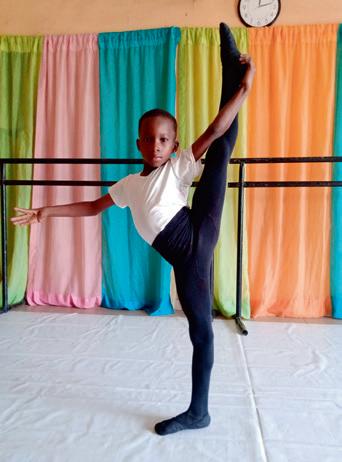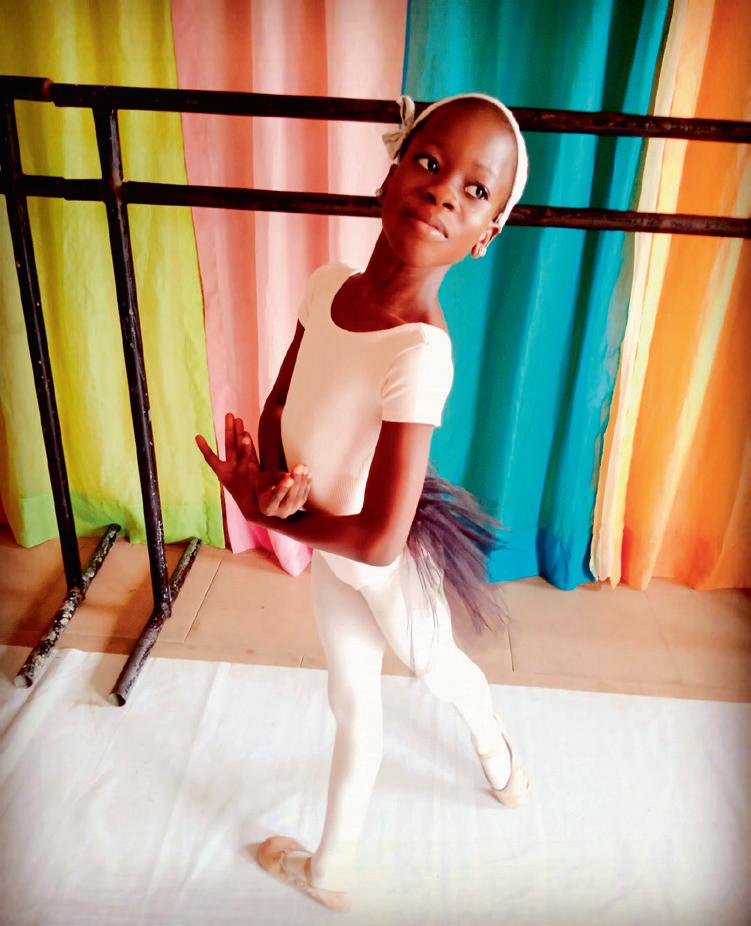
7 minute read
Ballet takes a leap in Lagos
Dancers hope to make leap to a new life
He’s inspired by a cheesy 20-year-old romantic film and learned his craft through YouTube videos, but in just two years Daniel Owoseni has trained students at his ballet academy in one of the most under-privileged neighbourhoods in Lagos to such a standard that the world is taking notice.
The rain is pouring down, collecting in puddles on an unsurfaced road in Lagos’ Ajangbani district, but it doesn’t seem to bother Anthony Mmesoma Madu. The 11-year-old ballet student is focused on his dancing, pirouetting in the puddles and performing soaring leaps, taking off on one bare foot and splashing down on the other. It’s a study in poise and focus oblivious to the harsh surroundings.
When the video of Madu’s dance was released on Instagram, it went viral, garnering hundreds of thousands of views around the world with Hollywood actresses Cynthia Erivo
and Viola Davis among those moved by what they saw. Oscar-winner Davis shared it on her Twitter page, saying it captured: “the beauty of my people. We create, soar… despite the brutal obstacles that have been put in front of us! Our people can fly!”
Mentors
Madu’s moves also so impressed the global Grishko brand of handmade point shoes and dance clothing it appointed Colombian ballet dancer and soloist Fernando Montaño to be his mentor while Cynthia Harvey, the artistic director of the ABT Jacqueline Kennedy Onassis School of Dance in New York, arranged a scholarship for Madu to come to the US to train next year and in the meantime is providing him with an online tutor to hone his skills.
The online training was also extended to the man responsible for instilling Madu’s love of ballet in Nigeria, Daniel Owoseni. Madu is one of a dozen students between the ages of six and 15 at Owoseni’s Leap of Dance Academy.
Owoseni set up the academy in 2017 in Afromedia Ajanbani in Oju, Lagos, and it offers far more to pupils than just free training in ballet. Ajanbani is a peaceful, low-income neighbourhood where childhood is often truncated by the need to provide for your family. The academy offers something beyond the grind to survive – an avenue of selfexpression and self-belief – but also a fortitude to take on life’s challenges.

Images courtesy of Leap of Dance Academy
Owoseni says: “Ballet is a very highly disciplined art and dancers don’t only use it in class but throughout one’s life. Our students carry themselves differently, they carry themselves with a sense of distinguished character and pride, with elegance and people notice that when they walk down the street.”
Such distinguishing deportment is in contrast to the stigma that singled the students out when the academy first opened. Then Owoseni struggled to get five students for his classes amid criticism among parents in the neighbourhood that dancing was just a distraction from schoolwork, would encourage laziness and was even indecent. However, the Lagos University graduate with a lifelong love of dancing is living proof that ballet and academic learning can coexist.
“I was able to convince them by being different, showing them not all dancers are loafers,” Owoseni says. “I told them I am a graduate of business administration, which that gave them a different approach instantly, seeing their children can still make good grades and dance also.
Taking a leap into dance
“We organised a programme called Sit and Read for our kids to read their regular school work and we assist them to get good grades in school. This also convinced the parents their kids are in good hands.”
Owoseni knows Oju well. The 29-year-old was born and raised here, in fact the classes at the academy – which does not currently have a permanent home – take place outside of Owoseni’s house or in a small nearby room when the weather is bad. He knows how difficult it is to pursue a career in dance when you live here. Central Lagos has a few dance schools, but they are private and prohibitively expensive for most residents.
When Owoseni was in Year 9 at High School and first fell in love with ballet watching the hit US film Save the Last Dance about an aspiring ballerina, he knew it was down to him if he wanted to follow his dream.
“I am self-taught and that has inspired me to learn more despite limited resources,” he says. “In Save the Last Dance, I saw the dedication and commitment it takes to do this kind of art and I told myself I want to do this. My go-to source of teaching was YouTube videos and Google searches, which gave me the best understanding I could get then.
“I had it in mind to take dance seriously and when I was at university, I had more exposure, but that was in African dance. When I finished my time with the National Youth Service Corps (NYSC) in 2016 I was running an outreach dance programme and that prepared me to begin work with the academy.
“When I was looking for a name for the academy, I remembered my background and that I had to take a step or a leap that was not considered to be possible. It wasn’t just any leap but a leap into dance and not just any dance but ballet.”
With the Leap of Dance Academy, Owoseni wants to give his students opportunities he didn’t have when he was their age, but at the same time he is looking for a quality in them that he can’t teach.
“Our students are selected with or no prior training,” he says. “Anyone can dance, but you get your place here once you show commitment and dedication.”
The dozen current students have that drive to improve. Madu has grabbed the headlines, but his video going viral has also raised global awareness of the depth of talent at the academy.
Amazing opportunities
“Many amazing opportunities have been presented to us now,” says Owoseni. “Our students have trained and continue to train at a highquality level so that when opportunities like this arise, they will be ready to travel and take their talent and hard work abroad. We have many scholarship opportunities around the world and we are very grateful. As for Nigeria we are at the forefront of making a name for dance and ballet here and we are hopeful for the future of dance in Africa.”
Owoseni has done wonderfully well to get his students to such a high level in just two years of training, but the recent rise in profile for the academy has seen worldrenowned teachers offering to lend a hand. With the covid travel restrictions most now are sharing their skills through online workshops. “We have many guest teachers coming in,” says Owoseni. the upcoming months to teach some workshops. Our current teachers online are Kat Wildish, Linda Hurkmans and Mary Hubbs from the Ballet Academy East in New York.”
International interest
There has been some financial support for the academy in the past in the form of small private donations and the students are kitted out for free in new and donated dancewear from international not-for-profit organisation Travelling Tutus, but Owoseni hopes to channel this increased international interest into funding for a permanent home for the academy.
“Once our academy is established as an NGO, we will be putting a website up where we will start raising funds to build our own dance school for the kids,” he says. “Recently, we have gained the support of many, which will put together resources for the students.”
It looks like this dedication and commitment is paying off for Owoseni and his pupils, who can be spotted in Ajangbani – the ones who hold their heads a little higher, their backs a little straighter and keep their eyes on their dance dream.
For more information, visit the Instagram page @leapofdanceacademy
Ballet basics
Getting started in ballet? Here are the three moves beginners have to master first.
plie (plee-ay): to bend. Keeping both feet flat on the floor at all times, bend your knees....
releve (ruh-leh-vay’): the dancer rises up onto the balls of their feet
saute (soh-tay): any jump on two feet landing on two feet.






